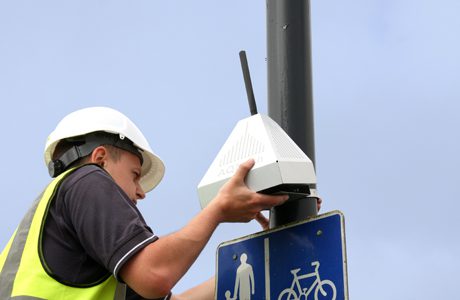The VW emissions scandal has helped to raise awareness of the deadly threat posed by air pollution in many of our towns and cities. In the following article, Jim Mills, Managing Director of Air Monitors, an instrumentation company, explains why diesel emissions will have to be lowered and how the latest monitoring technology will be an essential part of the solution.

Background
The World Health Organisation has estimated that over 500,000 Europeans die prematurely every year as a result of air pollution – especially fine particulates from combustion processes and vehicles. Of these, around 30,000 are in the UK; however, experts believe that the figures could be substantially higher if the effects of Nitrogen Dioxide (NO2) are also taken into consideration.
Historically, air pollution was highly visible, resulting in air pollution episodes such as the Great London Smog in 1952. However, today’s air pollution is largely invisible (fine particulates and NO2 for example), so networks of sophisticated monitors are necessary.
The greatest cause for alarm is the air quality in our major towns and cities where vehicles (main diesels) emit high levels of NO2 and particulates in ‘corridors’ that do not allow rapid dispersion and dilution of the pollutants. Urban vehicles also emit more pollution than free-flowing traffic because of the continual stopping and starting that is necessary.
As a result of its failure to meet European air quality limits, the Government was taken to the UK Supreme Court in April 2015 by ClientEarth, an organisation of environmental lawyers. In a unanimous judgement against Defra, the Court required the urgent development of new air quality plans. In September 2015 Defra published its Draft Air Quality Plans, but they have not been well received; respondents have described them as disappointing and unambitious. CIWEM, an organisation representing environmental management professionals, for example, said: (the plans) “rely on unfunded clean air zones and unproven vehicle emission standards.”
Some commentators believe that Defra should follow Scotland’s lead, following the publication, in November 2015, of ‘Cleaner Air for Scotland – The Road to a Healthier Future’ (CAFS). Key to this strategy is its partnership approach, which engages all stakeholders. Under CAFS, the Scottish Government will work closely with its agencies, regional transport partnerships, local authorities (transport, urban and land-use planners and environmental health), developers, employers, businesses and citizens. CAFS specifies a number of key performance indicators and places a heavy emphasis on monitoring. A National Low Emission Framework (NLEF) has been designed to enable local authorities to appraise, justify the business case for, and implement a range of, air quality improvement options related to transport (and associated land use).
Traffic-related air pollution
In addition to the fine particulates that are produced by vehicles, around 80% of NOx emissions in areas where the UK is exceeding NO2 limits are due to transport. The largest source is emissions from diesel light duty vehicles (cars and vans). Clearly, there is now enormous pressure on vehicle manufacturers to improve the quality of emissions, but urgent political initiatives are necessary to address the public health crisis caused by air pollution.
A move to electric and hybrid vehicles is already underway and developments in battery technology will help improve the range and performance of these vehicles, and as they become more popular, their cost is likely to lower. The prospect of driverless vehicles also offers hope for the future; if proven successful, they will reduce the need for car ownership, especially in cities, thereby reducing the volume of pollution emitting vehicles on the roads.
Vehicle testing is moving out of the laboratory in favour of real-world driving emissions testing (RDE) which will help consumers to choose genuinely ‘clean’ vehicles. However, the ultimate test of all initiatives to reduce traffic-related air pollution is the effect that they have on the air that people breathe.

Ambient air quality monitoring
Networks of fixed air quality monitoring stations provide continual data across the UK, accessible via the Defra website and the uBreathe APP. Many believe that this network contains an insufficient number of monitoring points because measurement data has to be heavily supplemented with modelling. However, these reference monitoring stations, while delivering highly accurate and precise data, are expensive to purchase, calibrate and service. They also require a significant footprint and mains electricity, so it is often difficult or impossible to locate them in the locations of most interest – the pollution hotspots.
Public sector budgets are under pressure, so the cost of running the national monitoring network and those systems operated by Local Authorities is a constant source of debate. The challenge for technology companies is therefore to develop air quality monitors that are more flexible in the locations in which they are able to operate and less costly in doing so.
New technology: ‘AQMesh’
Air Monitors has developed a small, battery-powered, web-enabled, air quality monitor ‘AQMesh’, which can be quickly and easily mounted on any lamp post or telegraph pole at a fraction of the cost of traditional monitors. Consequently, for the first time ever, it is possible to monitor air quality effectively, where it matters most; outside schools, on the busiest streets and in the places where large numbers of people live and breathe.
AQMesh ‘pods’ are completely wireless, using GPRS communications to transmit data for the five main air polluting gases to ‘the cloud’ where sophisticated data management generates highly accurate readings as well as monitoring hardware performance. In addition, it is now possible to add a particulate monitor to new AQMesh pods.
AQMesh does not deliver the same level of precision as reference stations, but this new technology decreases the cost of monitoring whilst radically improving the availability of monitoring data, especially in urban areas where air quality varies from street to street.
The flexibility of these new monitors is already being exploited by those responsible for traffic-related pollution – helping to measure the effects of traffic management changes for example. However, this new level of air quality data will also be of great value to the public; helping them to decide where to live, which routes to take to work and which schools to send their children to.






